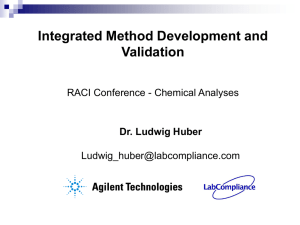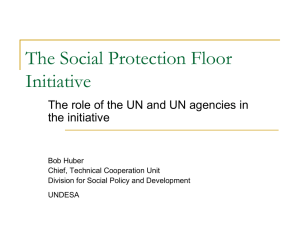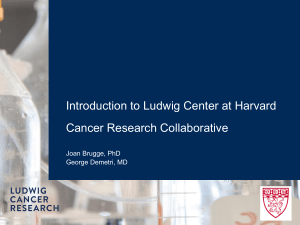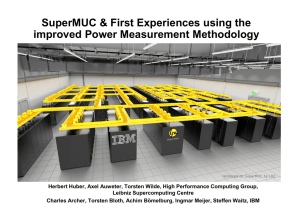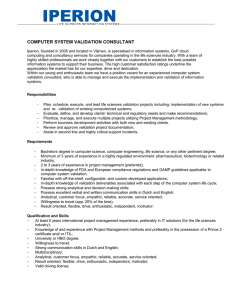Inter-Laboratory Method Transfer
advertisement
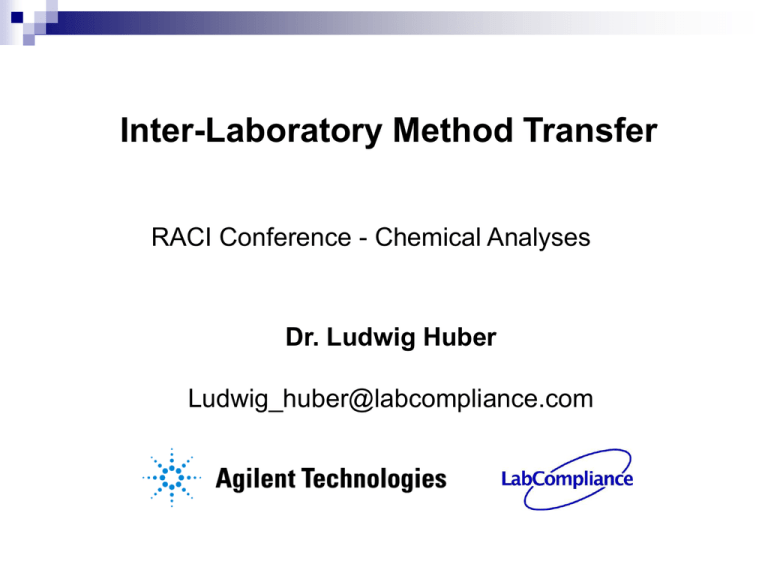
Inter-Laboratory Method Transfer RACI Conference - Chemical Analyses Dr. Ludwig Huber Ludwig_huber@labcompliance.com Overview • Regulatory expectations • Four approaches for analytical method transfer • Experiments and acceptance criteria for comparative testing • •Effective planning, execution and documentation of method transfer © Copyright Ludwig Huber - LabCompliance Slide 2 Occurrence of Method Transfer • Sponsor company to contract lab • Analytical development to QC labs • Across different sites – The same lab conditions – Different lab conditions • Existing to new instrumentation – With different specifications – With different technology • Supplier of material to client • Transfer to new instruments with different instrument characteristics © Copyright Ludwig Huber - LabCompliance Slide 3 Transfer of Analytical Procedures Definition According to USP <1224> • The transfer of analytical procedures (TAP), also referred to as method transfer, is a documented process that qualifies a laboratory (the receiving unit) to use an analytical test procedure that originated in an other laboratory (the transferring unit, also referred as the sending unit), • Thus ensuring that the receiving unit has the procedural knowledge and ability to perform the transferred analytical .procedure as intended. © Copyright Ludwig Huber - LabCompliance Slide 4 Why Controlled Method Transfer • Expected by agencies – The suitability of all testing methods used shall be verified under actual condition of use • Reduces failure rate • Improves the quality of the testing at the new place Problems can come up due to different equipment, different analysts and lab environment © Copyright Ludwig Huber - LabCompliance Slide 5 FDA CGMP Regulation 21 CFR Part 211.194 (a) (2) • Laboratory records shall include a statement of each method used in the testing of the sample. • The statement shall indicate the location of data that establish that the methods used in the testing of the sample meet proper standards of accuracy and reliability as applied to the product tested • The suitability of all testing methods used shall be verified under actual condition of use. © Copyright Ludwig Huber - LabCompliance Slide 6 FDA Warning Letter • The firm failed to perform finished product test method transfers for 34 products (W-187) • The firm has failed to perform method validations, method verifications, or method transfers for any of the laboratory test methods used to test active pharmaceutical ingredients (W-187) Ref: www.fdawarningletter.com © Copyright Ludwig Huber - LabCompliance Slide 7 Warning Letter • Failure to establish and document the accuracy and reproducibility of test methods employed. (W-186) • For example, methods that were validated at one facility and transferred to xxx site are being used without a methods transfer or revalidation protocol. (W-186) Ref: www.fdawarningletter.com © Copyright Ludwig Huber - LabCompliance Slide 8 USP Chapter <1224>; Risk Based Approach for Transfer of Analytical Procedures: • • • • Concept Paper Published in Pharmacopeial Forum, Nov 2009 Draft Chapter published in Pharmacopeial Forum , Jan 2011 Final chapter for USP 35 (May 1, 2012) Content – Focus on risk based approach – Discussion of 4 types of analytical transfer – Elements recommended for transfer of analytical procedures – Emphasizes importance of transfer protocol – The analytical procedure and report © Copyright Ludwig Huber - LabCompliance Slide 9 USP Chapter <1224>; Risk Based Approach for Transfer of Analytical Procedures • The tests that will be transferred, the extent of the transfer activities, and the implementation strategy should be based on risk analysis that considers the – previous experience and – knowledge of the receiving unit – the complexity and – specifications of the product, and – the procedure © Copyright Ludwig Huber - LabCompliance Slide 10 Options for Method Transfer • • • • Comparative Testing Co-validation Complete or partial validation or revalidation Omission of formal transfer (waiver) Criteria: type of method (simple, complex), experience and capabilities of receiving lab © Copyright Ludwig Huber - LabCompliance Slide 11 Co-validation • Receiving lab is part of original method validation • Transferring and receiving lab conduct the same validation experiments • Useful for methods not (fully) validated • Must be based on pre-approved validation protocols and acceptance criteria • Should challenge all USP or ICH validation parameters • Include receiving lab in validation through interlaboratory tests. • Ensures harmonization of method at both sites A site that performs validation studies is qualified to run the method © Copyright Ludwig Huber - LabCompliance Slide 12 Full or Partial Revalidation • Received lab repeats some or all of the validation experiment • Done after initial method validation • Validation parameters depend on the method e.g., – Limit selectivity and limit quantitation for impurities – Precision for content uniformity assays Similar process as verification of compendial methods © Copyright Ludwig Huber - LabCompliance Slide 13 Transfer Waivers • Method is used without dedicated transfer testing • Reasons should be well justified and documented – The new product’s composition is comparable to that of an existing product and/or the concentration of active ingredient is similar to that of an existing product and is analyzed by procedures with which the receiving unit already has experience – The analytical procedure transferred is the same as or very similar to a procedure already in use – The personnel in charge of the development, validation or routine analysis of the product at the transferring unit are moved to the receiving unit – Transfer of compendial methods (refer to USP <1226>) Waiver should be well justified and documented © Copyright Ludwig Huber - LabCompliance Slide 14 Comparative Testing • • • • • • Most frequently used The same tests are carried out by both labs Should only be performed with validated methods Based on pre-approved transfer protocol (TAP) Predetermined number of samples of the same lot Well defined test procedures and acceptance criteria, including acceptable variability • Results are compared with a set of predetermined acceptance criteria © Copyright Ludwig Huber - LabCompliance Slide 15 Prerequisites for Successful Method Transfer • Analytical method validated – Includes ruggedness testing – Includes robustness testing • Scope well defined – Sample, matrix – Performance characteristics, acceptance criteria – Equipment © Copyright Ludwig Huber - LabCompliance Slide 16 Required Documents • Transfer Master Plan (TMP) used as frame work • Transfer project plan or method transfer protocol (MTP) – Approach for controlled transfer and justification • SOPS for step-by-step implementation • Templates and forms for efficiency and consistency • Analytical procedure • Original validation report • Historical data on method reliability and performance (to identify greatest causes of variance) © Copyright Ludwig Huber - LabCompliance Slide 17 Transfer Plan or MT Protocol • • • • • Reason and purpose of the transfer Scope of the plan and method transfer The approach Description of transfer process Responsibilities – Transferring, receiving labs, project owners, QA • Assumptions – E.g., Analysts in the receiving lab not familiar with the method • Training details • Test Plan MTP = Method Transfer Protocol © Copyright Ludwig Huber - LabCompliance Slide 18 Test Plan • • • • • • • • • Tests to be performed and test parameters Rational behind tests Description of materials and samples Description of equipment Number of lots, batches replicates, injections Pitfalls that may be encountered Test schedule Acceptance criteria Documentation, approvals © Copyright Ludwig Huber - LabCompliance Slide 19 Responsibilities Project Owners • Transferring lab – Develops transfer plan – Develops for procedures for comparative testing – Arranges equipment for training and testing – Arranges for people for training and testing – Arranges for preparation of test sample(s) – Documents comparative sample testing • Receiving Labs – Arranges for equipment for training and testing – Arranges for people for training and testing – Documents comparative sample testing © Copyright Ludwig Huber - LabCompliance Slide 20 Responsibilities of Analysts • Transferring lab – Train analysts in receiving laboratories – Perform and document comparative sample testing – Sign test results – Share experience with test method • Receiving Labs – Get trained on method – Perform comparative sample testing – Sign test results – Give feedback on test method © Copyright Ludwig Huber - LabCompliance Slide 21 Other Responsibilities At transferring and receiving lab • Lab supervisor – Designate project owner – Provide resources for testing – Review and approve validation documents • Quality Assurance – Review and approve transfer plan – Review and approve validation documents © Copyright Ludwig Huber - LabCompliance Slide 22 Steps for Comparative Testing • • • • • Develop and approve a test plan Order missing equipment and materials Training Concurrent execution of the protocol Evaluation of test results – Compare with acceptance criteria • Resolution of deviations, if there are any • Gather all required documents • Write method transfer report (MTR) © Copyright Ludwig Huber - LabCompliance Slide 23 Considerations for Testing • • • • • • © Copyright Number of samples (1-3) One or more concentrations (1-3) Number of repetitive analysis / sample (4-6) One or more analysts? (1-2) One or more days? (2-5) Equipment from one or more manufacturers? (1 - all) Ludwig Huber - LabCompliance Slide 24 Evaluation of Test Results Direct comparison with acceptance criteria • Based on product release criteria • Based on criteria for method validation – Accuracy, precision, specificity Use of statistics will build objectivity into the test result and allow unbiased comparison of data sets © Copyright Ludwig Huber - LabCompliance Slide 25 Example: API in Finished Drugs Sample Amount % of test concentration Measure Acceptance as % of target 50% Accuracy 3 replicates All 97 - 103 100% Accuracy 3 replicates All 98 - 102 150% Accuracy 3 replicates All 98 -102 Results #1: 98 #2: 99 #3: 99 #1: 101 #2: 100 #3: 101 #1: 101 #2: 99 #3: 100 System Suitability Tests must pass • Resolution between two most critical compounds >2 • Precision of amounts based on 6 sample runs: RSD < 1% for 100% of test concentration © Copyright Page 26 Ludwig Huber - LabCompliance Slide 26 Example: Quantitative Impurities Sample Amount Measure Acceptance as % of target At LOQ = 0.5 x specification limit Accuracy 3 replicates All 85 - 115 At 5 x LOQ Accuracy 3 replicates All 94 - 106 At 20 x LOQ Accuracy 3 replicates All 96 -104 Results #1: 96 #2: 98 #3: 108 #1: 98 #2: 103 #3: 99 #1: 101 #2: 99 #3: 100 System Suitability Tests must pass • Resolution between two most critical compounds >2 • Precision of amounts based on 6 sample runs: RSD < 4% for 5x LOQ © Copyright Page 27 Ludwig Huber - LabCompliance Slide 27 Check Variability by Operator, Instrument and Day Two instruments, two operators, three days Sample Instrument Operator Day 100% conc. (3x) 1 1 1 100% conc. (3x) 1 2 2 100% conc. (3x) 1 3 3 100% conc. (3x) 2 1 2 100% conc. (3x) 2 2 3 100% conc. (3x) 2 3 1 Example: API in finished drugs, 100% of test concentration • Acceptance: RSD < 2% Ludwig Huber © Copyright Ludwig Huber - LabCompliance Page 28 Review and Approvals • Transfer plan and result has to be accepted by both laboratories • Approval of the result by at least – The test person – Technical supervisor – QA • Review and acceptance by all responsible people © Copyright Ludwig Huber - LabCompliance Slide 29 Recommendations for Deviations • • • • • • © Copyright If the tests don’t pass acceptance criteria, identify the source of the problem Develop corrective action plan – Provide additional training – Use other equipment Update the procedure Repeat the tests If successful, document initial results, corrective actions and final results If not successful, develop alternative procedure Ludwig Huber - LabCompliance Slide 30 Method Transfer Report Report items and format to be specified in the study transfer plan • Summary of method familiarization results • Detailed results of transfer study • Description of any deviations and from expected results and how they have been resolved • Signatures of individuals responsible for transfer studies • Copies of supporting material, e.g., chromatograms and spectra • Conclusion and assessment of the transfer study results © Copyright Ludwig Huber - LabCompliance Slide 31 Thank You I would like to thank • All attendees for your attention • Agilent Technologies for invitation and organizatopn Give feedback and choose any two from over 150 documents (value: $138) for free: SOPS and/or Validation examples. GOTO: www.labcompliance.com/misc/conferences/feedback.aspx Offer expires on March 10, 2014 For links to Method Validation references, please check www.labcompliance.com/agilent (Available until March 10, 2014) © Copyright Ludwig Huber - LabCompliance Slide 32
